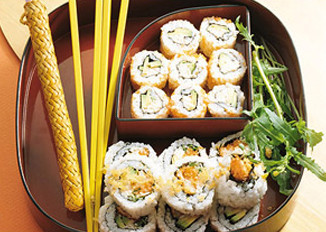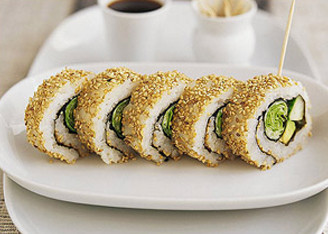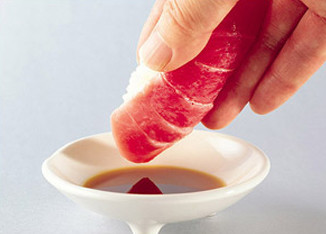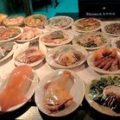 American RollsWhen in the 1970sThe first Japanese restaurant Tokyo Kaikan opened in Los Angeles, with Ikiro Mashita as its chef. The chef studied American tastes and found that most of them do not like nori, especially the type of seaweed traditionally used to wrap sushi, and do not accept raw fish. To disguise the nori, Mashita hid it inside the rice, that is, he rolled the roll inside out, following the principle of preparing Japanese uramaki, and instead of fish for an oily texture, he added a slice of avocado and crab meat for flavor, complemented it with a slice of cucumber and rolled it in tobiko (flying fish roe). California rolls instantly became a hit and contributed to the popularization of sushi in general in American culture. California rolls inspired chefs to create many variations of sushi. Americans have come up with more than a dozen of them. The American approach to sushi, unlike the Japanese, is quite simple: cook according to the principle of "put in what you like". That is, in essence, for many Americans sushi is just a kind of sandwich. As a result, there are spider rolls, Philadelphia rolls, Boston rolls, New York rolls, Texas rolls, rainbow rolls, Chicago bulls rolls and others in the world. Today, almost every self-respecting sushi bar has its own signature roll. But you won't find all these American varieties in Japan anymore, you've hardly even heard of them there. And you'd better not explain to the Japanese how to make sushi with fried banana and Philadelphia cheese, so as not to offend their national pride.
American RollsWhen in the 1970sThe first Japanese restaurant Tokyo Kaikan opened in Los Angeles, with Ikiro Mashita as its chef. The chef studied American tastes and found that most of them do not like nori, especially the type of seaweed traditionally used to wrap sushi, and do not accept raw fish. To disguise the nori, Mashita hid it inside the rice, that is, he rolled the roll inside out, following the principle of preparing Japanese uramaki, and instead of fish for an oily texture, he added a slice of avocado and crab meat for flavor, complemented it with a slice of cucumber and rolled it in tobiko (flying fish roe). California rolls instantly became a hit and contributed to the popularization of sushi in general in American culture. California rolls inspired chefs to create many variations of sushi. Americans have come up with more than a dozen of them. The American approach to sushi, unlike the Japanese, is quite simple: cook according to the principle of "put in what you like". That is, in essence, for many Americans sushi is just a kind of sandwich. As a result, there are spider rolls, Philadelphia rolls, Boston rolls, New York rolls, Texas rolls, rainbow rolls, Chicago bulls rolls and others in the world. Today, almost every self-respecting sushi bar has its own signature roll. But you won't find all these American varieties in Japan anymore, you've hardly even heard of them there. And you'd better not explain to the Japanese how to make sushi with fried banana and Philadelphia cheese, so as not to offend their national pride. California rolls California rolls themselvesalso come in a variety of varieties. For example, one Hawaiian chef rolls his rolls in emerald-colored tobiko, achieving such a stunning effect by mixing the caviar with wasabi. There are very hot versions with the addition of hot habanero peppers, they are called Kamikazi California, remember this when you open the menu! Mexicans also love rolls and prepare them in their own way: with smoked salmon, spinach, chipotle sauce, manchego cheese. Here are just a few common combinations on the theme of sushi:
California rolls California rolls themselvesalso come in a variety of varieties. For example, one Hawaiian chef rolls his rolls in emerald-colored tobiko, achieving such a stunning effect by mixing the caviar with wasabi. There are very hot versions with the addition of hot habanero peppers, they are called Kamikazi California, remember this when you open the menu! Mexicans also love rolls and prepare them in their own way: with smoked salmon, spinach, chipotle sauce, manchego cheese. Here are just a few common combinations on the theme of sushi:
- Boston Rolls: Green Onions, Crab Meat, Salmon
- Holiday Rolls: Cranberry, Turkey, Cream Cheese
- New York Rolls: Apple, Avocado, Smoked Salmon
- Pesto Rolls: Pesto, Chicken or Turkey, Cream Cheese
- Philadelphia Rolls: Smoked Salmon, Cucumber, Cream Cheese
- Texas Rolls: Beef, Cucumber, Spinach
- New Zealand Rolls: Cucumber, Avocado, Kiwi
In the Guinness Book of Records, CaliforniansRolls have also taken their place. The longest roll was rolled on February 14, 2001 in Hawaii. Its length was 91.4 meters, and its preparation required over 90 kg of rice, 150 pounds of crab meat, 100 yards of noria, 5 gallons of mayonnaise, 60 pounds of cucumbers, the same amount of avocado and 4 pounds of wasabi.
Sushi etiquette, or how to eat sushi
 When you order sushi, togetherWith your dish you will be brought warm towels so that you can wipe your hands before eating. Sushi is eaten only with your hands. An exception is made for Americans and Europeans, and also for women, but according to the rules of etiquette neither a Japanese nor a true sushi chef will eat sushi with chopsticks. Also, with sushi you will be served pickled ginger, a little wasabi and soy sauce. The ginger is needed to neutralize the taste of the previous type of sushi before trying a new one. A small piece of ginger is enough to just chew. Wasabi should not be mixed with soy sauce. Do not dip the sushi rice side down into the sauce, this may cause the sushi to fall apart. Sushi is usually eaten whole, it is unacceptable to bite off a piece of sushi and return the remainder back to the plate.
When you order sushi, togetherWith your dish you will be brought warm towels so that you can wipe your hands before eating. Sushi is eaten only with your hands. An exception is made for Americans and Europeans, and also for women, but according to the rules of etiquette neither a Japanese nor a true sushi chef will eat sushi with chopsticks. Also, with sushi you will be served pickled ginger, a little wasabi and soy sauce. The ginger is needed to neutralize the taste of the previous type of sushi before trying a new one. A small piece of ginger is enough to just chew. Wasabi should not be mixed with soy sauce. Do not dip the sushi rice side down into the sauce, this may cause the sushi to fall apart. Sushi is usually eaten whole, it is unacceptable to bite off a piece of sushi and return the remainder back to the plate.









